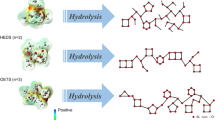Summary
Reactions of hexamethylcyclotrisiloxane, D3, with 1,1,3,3-tetramethyldisiloxane, HMMH, 1,1,1,3,3-pentamethyldisiloxane, HMM, phenyldimethylsilane and phenylmethylsilane catalyzed by tris(pentafluorophenyl)borane were studied. These reactions lead to ring opening of D3 by the SiH reactant producing open chain oligomers with hydrosilane functionality at one or both chain ends. The reactivity of the hydrosilanes toward D3 decreases in the series: PhMeSiH2 > HMMH > PhMe2SiH > HMM. Competitive self-oligomerization of HMMH and HMM also occurs. Primary products of these processes are able to enter into reactions with the SiH and D3 reactants; some also undergo cyclization. Thus, consecutive and competitive processes lead to a series of various oligohomologues. Gas chromatography in conjunction with chemical ionization mass spectroscopy permitted identification of structure and determination of the basic directions of these oligomerization processes. Polysiloxanes of higher molecular weight may be also formed in some of these systems. The reactions, which occur in the systems studied, are rationalized on the basis of the mechanism involving the hydride transfer from silicon to trivalent boron. This includes the transient formation of tertiary trisilyloxonium borate which decomposes by the hydride transfer to one of the silicon atoms of the trisilyloxonium center.












Similar content being viewed by others
References
You-Xian Chen E., Marks T. J.(2000) Chem. Rev. 100:1391
Coates G. W., Hustad P. D., and Reinartz S.(2002) Angew. Chem. Int. Ed. 41:2236
Yang Y. G., Choi D. S., and Han S.(2004) J. Polym. Sci., Part A, Polym. Chem. 42:1164
Ban H. T., Kase T., Kawabe M. et al.(2006) Macromolecules 39:171
Piers W.E (2005) Adv. Organomet. Chem. 52:1
G. Erker, J. Chem. Soc. Delton Trans., 1883 (2005)
Hassfeld J., Christmann M., and Kalesse M. (2001) Org. Lett. 3:3561
Chandrasekhar S., Reddy C. R., and Chandrasekhar G. (2004) Tetrahedron Lett. 45:6481
Marshall A. J., and Gill K.(2001) J. Organomet. Chem. 624:294
K. Ishihara, and H. Yamamoto Eur. J. Org. Chem. 527 (1999)
Blackwell J. M., Foster K. L., Beck V. H., and Piers W.E.(1999) J. Org. Chem. 64:4887
Blackwell J. M., Sonmor E. R., Scoccitti T., and Piers W. E.(2000) Org. Lett. 2:3921
Gevorgian V., Liu J. -X., Rubin M., Benson V, and Yamamoto Y.(1999) Tetrahedron Lett. 40:8919
Gevorgian V., Rubin M., Benson S., Liu J. -X., and Yamamoto Y.(2000) J. Org. Chem. 65:6179
Rubinsztajn S. and Cella J.(2005) Macromolecules 38:1061
Zhou D.Q., and Kawakami Y. (2006) Macromolecules 38:6902
Chojnowski J., Rubinsztajn S., Cella J., Fortuniak W., Cypryk M., Kurjata J., and Kaźmierski K.(2005) Organometallics 24:6077
Chojnowski J., Fortuniak W., Kurjata J., Rubinsztajn S., and Cella J.(2006) Macromolecules 39:3802
G. Belorgey, and G. Sauvet, in Silicon Containing Polymers, R. G. Jones, W. Ando, and J. Chojnowski, eds. (Kluwer Academic Publishers, Dordrecht, 2000), Chap. 2. pp 43–78.
Acknowledgments
The financial support from General Electric Company is gratefully acknowledged.
Author information
Authors and Affiliations
Corresponding author
Additional information
Footnote: This paper is dedicated to Professor Ian Manners in recognition of his significant contributions to the field of organometallic polymers.
Rights and permissions
About this article
Cite this article
Chojnowski, J., Rubinsztajn, S., Fortuniak, W. et al. Oligomer and Polymer Formation in Hexamethylcyclotrisiloxane (D3) – Hydrosilane Systems Under Catalysis by tris(pentafluorophenyl)borane. J Inorg Organomet Polym 17, 173–187 (2007). https://doi.org/10.1007/s10904-006-9083-2
Published:
Issue Date:
DOI: https://doi.org/10.1007/s10904-006-9083-2



